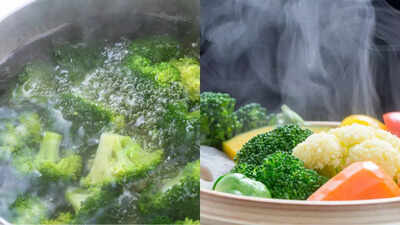
Cooking vegetables is one of the easiest ways to add nutrients to your daily meals, but how you cook them can make a big difference to their health benefits. Steaming and boiling are two of the most common, oil-free cooking methods used in homes. While both soften vegetables and make them easier to digest, they differ greatly in how they affect flavour, texture, and nutrient content. Steaming is often praised for preserving vitamins and minerals, while boiling is valued for its simplicity and ability to tenderise dense vegetables. Understanding the science behind each method helps you make the most of your vegetables without losing their natural goodness. Here’s a closer look at how steaming and boiling compare, and which one is truly healthier.
Why steaming is considered the healthiest way to cook vegetables
Steaming cooks vegetables gently using hot vapour instead of direct contact with water. The vegetables are placed above boiling water in a steamer basket, so the steam surrounds and softens them without washing away nutrients. This method helps retain more vitamins, especially water-soluble ones like vitamin C and B-complex, which are easily lost through boiling.Steamed vegetables also look brighter and taste fresher. Broccoli stays green and crisp, carrots turn rich orange, and beans hold their crunch. Because there’s no need for oil, steaming supports weight management and heart health. To enhance flavour naturally, you can add herbs, garlic, or lemon slices to the water. Experts note that steaming is among the healthiest cooking techniques since it preserves both nutrition and natural taste.
Boiling vegetables : Simple and quick, but not the best for nutrient retention
Boiling is one of the most common cooking methods, simple, fast, and perfect for soups or mashed dishes. Vegetables are fully submerged in hot water and cooked until soft. However, this convenience comes with a downside: nutrient loss. Water-soluble vitamins and minerals leach into the water during boiling. Unless that water is reused, many nutrients are lost.Still, boiling has its advantages. It makes starchy vegetables like potatoes, beetroot, and sweet potatoes softer, creamier, and easier to digest. To reduce nutrient loss, always add vegetables to boiling water rather than cold water, and cook them only until tender. You can also reuse the leftover water for soups, stews, or gravies to retain some of the vitamins.
Steaming vs boiling: Which retains more nutrients
When it comes to nutrition, steaming clearly has the upper hand. According to a study published in the Journal of Agricultural and Food Chemistry, steaming helps preserve more antioxidants and vitamins than boiling. Since vegetables do not come in direct contact with water, fewer nutrients leach out, maintaining their natural flavour, colour, and nutritional value.Steamed vegetables also stay colourful, firm, and naturally sweet, making them more appealing. Boiled vegetables, on the other hand, can look dull and taste bland if overcooked. From a wellness point of view, Ayurveda also supports steaming as a sattvic method, meaning it preserves the life energy (prana) in food, making it lighter and easier to digest. That said, boiling can still be the better option for certain dishes or when a softer texture is needed, such as for soups, curries, or baby meals.
Common mistakes to avoid while cooking vegetables
Even healthy methods can go wrong if not done properly. When steaming, avoid overcooking, vegetables should remain firm and bright, not soggy. Do not overcrowd the steamer, as steam must circulate freely for even cooking. Cutting vegetables into similar sizes also helps them cook evenly.For boiling, the most common mistake is leaving vegetables in water for too long. Overboiling strips nutrients and ruins texture. Most vegetables need only 3–6 minutes to cook perfectly. Adding a pinch of salt enhances flavour, and plunging green vegetables into cold water immediately after boiling helps maintain their bright colour.
Steaming or boiling: How to choose the healthiest cooking method
Both steaming and boiling play important roles in healthy cooking, and choosing between them depends on the type of vegetables and the result you want. Steaming helps lock in nutrients, natural colour, and crunch, making it ideal for tender vegetables such as broccoli, beans, carrots, and spinach. Because the food doesn’t touch water directly, vital vitamins like vitamin C and folate stay intact.Boiling, on the other hand, is better for dense or starchy vegetables like potatoes, beetroot, and sweet potatoes. It softens their texture and makes them easier to mash or blend for soups and comfort dishes.For maximum benefit, you can even combine both methods. Start by lightly boiling hard vegetables, then finish with a short steam to retain their nutrients and improve texture. In the end, healthy cooking is all about balance and awareness. Steaming keeps vegetables light, crisp, and nutrient-rich, while boiling adds warmth and comfort. By knowing when to use each technique, you can create meals that are wholesome, tasty, and satisfying every time.Also Read: 5 side effects of eating too many kiwis: What happens when you overeat this fruit






